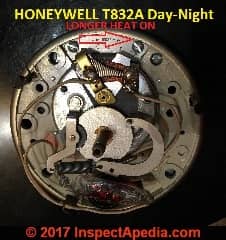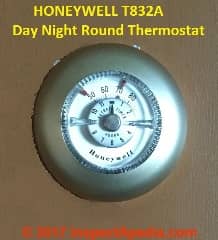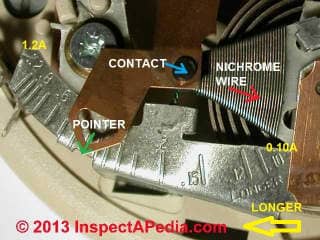 Thermostat Heat Anticipator FAQs
Thermostat Heat Anticipator FAQs
- POST a QUESTION or COMMENT about thermostat heat anticipator circuits & controls.
Thermostat heat anticipator function & adjustment FAQs:
Questions & answers about how a room thermostat heat anticipator works.
This article series explains how adjusting the heat anticipator pointer changes the heat output of the anticipator that in turn changes the behaviour of the room thermostat to turn the burner off sooner or later with respect to the actual room temperature.
Our page top photo illustrates key parts of a traditional room thermostat heat anticipator assembly.
InspectAPedia tolerates no conflicts of interest. We have no relationship with advertisers, products, or services discussed at this website.
Thermostat Heat Anticipator Questions & Answers
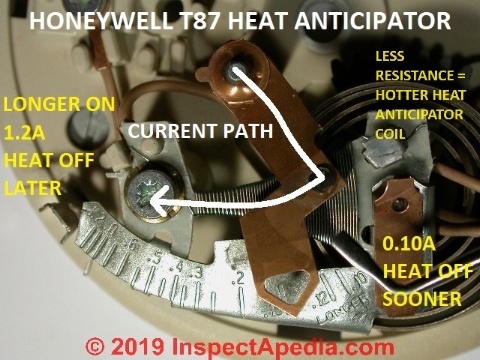
These room thermostat heat anticipator questions and answers were posted originally at HEAT ANTICIPATOR OPERATION - be sure to review that article's explanation of heat anticipators.
In our photograph you'll see the word LONGER stamped into the right end of the heat anticipator scale in our photograph from a Honeywell T87 thermostat.
At that right end of the scale you'll see that the current number is 0.10 Amps - the lowest current level on the heat anticipator's Amps or Current scale.
At higher Amps more current flows through the wire, the wire is hotter, the heat anticipator puts out more heat, the room thermostat is warmed internally, and heat will shut off sooner - so at 1.2A we have the shorter heat-on cycle and at 0.1A we have the longer heat-on cycle.
[Click to enlarge any photo]
Reader Comment: Ohm's Law explains why the heat anticipator operates as a little heater: more heat at lower resistance settings
(Mar 18, 2014) Tim said:
According to the copy of Ohm's that I have,
Watts = Volts2 / Ohms
See DEFINITIONS of ELECTRICAL TERMS for definitions of watts, volts, & ohms or resistance. - Ed.
[Click to enlarge any image]
Therefore watts (and heating effect) goes up as the resistance goes down, given the same voltage. This also applies to amps (volts / ohms). This would explain what Honeywell is telling you.
Since electrical resistance is a measurement of the opposition to (resistance to) the flow of electric current, lower resistance means more current flow.
Reply: we agree.
Moving the heat anticipator so that the current runs through a shorter wire lowers the electrical resistance of the heat anticipator.
Lower electrical resistance (measured in Ohms) will permit more current to flow in a wire when we don't change the voltage.
Higher electrical current (measured in Amps) is expected to cause more energy to be released in the form of heat. Why?
Current flowing through a wire that acts as a resistor will convert electrical energy to heat.
More current flow = more heat.
More heat from the heat anticipator means more warming of the interior of the room thermostat, causing it to turn OFF the heating system a bit sooner.
Why the Heat Anticipator Heater Gets Hot
The comparatively large #18 copper thermostat wire that brings electrical power to the room thermostat has maybe 50 times less resistance than the short length of nichrome wire in the thermostat heat anticipator's heater.
So the 24VAC fed into the little heater warms up the nichrome wire - where it's functioning similarly to the filament in a light bulb fed by #14 copper wire in a house circuit.
When we adjust the heat anticipator to a higher Amps number we shorten the nichrome wire to lower its resistance still further, more current is pushed through it and it gets still hotter.
See ELECTRICAL RESISTANCE vs HEAT GENERATED for details about resistance of wires and why they get hot - or don't.
See HEAT ANTICIPATOR SET & TEST by AMMETER for a description of the typical amps range of a room thermostat circuit.
Question: Operation of the Heat Anticipator on a Honeywell T832A Day-Night Setback Thermostat
I have a Honeywell T832A thermostat with a mechanical setback timer and I don't quite understand how it's anticipator is supposed to work. It can be set from 0.4 to 1 amp but moving the pointer seems to do nothing as the cycles are always too long.
I partially disassembled it to show how it's made and you can see that the anticipator isn't anywhere near the bi-metal coil, it's sitting about 2" above it above the mechanical timer assembly.
It's also wired in a way I don't understand.
Can anyone explained how this is supposed to work? Look at these photos. [Click to enlarge any image]
Reply: Heat Anticipator Operation on the Honeywell T832A - numbers run opposite to newer thermostats
Hil R.
I took a look at your photos of the Honeywell T832A thermostat and have reproduced them here for other readers. The Honeywell T832 day-night thermostat was first produced by Honeywell in 1960 continuing the sophistication of Honeywell's round thermostat series originally designed by Henry Dreyfuss and first sold in 1953.
The T832 1960's day-night setback thermostat, shown above and edited from one of your photo series, contains a wind-up timer that permitted an automatic night time temperature setback.
The Honeywell 832 number continues in use as the Honeywell TH832R1001 Vision Pro electronic, programmable touch screen thermostat that is an entirely new device.
Watch out: Honeywell, in instructions for its CT87A,B,J Round Thermostat warns [that unless your specific primary control manufacturer says otherwise]
Never adjust the heat anticipator below 0.3A
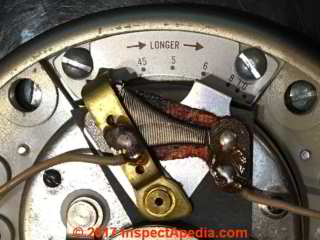 You'll see that you have set the heat anticipator adjustment pointer to the left end of the scale - that's somewhere around 0.1A of current, calling for least current in Amps [assuming this scale is expressed in Amps], least heating by the heat anticipator.
You'll see that you have set the heat anticipator adjustment pointer to the left end of the scale - that's somewhere around 0.1A of current, calling for least current in Amps [assuming this scale is expressed in Amps], least heating by the heat anticipator.
That should give the longest heat-on cycle.
What's confusing is that the printed arrows on the T832A point towards higher Amps numbers the label and arrows indicating LONGER also point towards the higher numbers on the scale.
On other heat anticipators like the Honeywell T87 I show higher on this page, the stamping LONGER is at the numerically lower end of the heat anticipator scale, around 0.1A - opposite to your device.
Looking at the wiring in your thermostat it's apparent that when you push the pointer over in the LONGER direction (towards 1.0 on the scale) we are going to be using the shortest length of nichrome wire.
Nichrome is the short name for wire made of a nickel-iron-chromium alloy that is commonly used in heating elements buecause it can get quite hot without falling apart.
The shortest length of wire permits the least resistance, thus the most current flow, thus the most heat output from the heat anticipator. More output from the heat anticipator should turn the thermostat off sooner, rather than later, giving a shorter, rather than a longer heat-on cycle.
So I was confused too. But take a look at the geometry of your heat anticipator in the T832A (above) in comparison with that of a T87 (below).
On your T832A moving the contact from left to right moves towards the narrow or fewer windings and towards a higher number on the scale and in the direction of LONGER - presumably heating cycle length.
 On the T87 moving the pointer from left to right moves towards the wide or greater number of windings, towards a lower number on its scale, and in the direction of LONGER.
On the T87 moving the pointer from left to right moves towards the wide or greater number of windings, towards a lower number on its scale, and in the direction of LONGER.
I can only guess that the older Honeywell T832A that you've got is more than a collector's item, it is working differently. Perhaps the coil used in your thermostat is designed to operate a bimetallic spring whose winding moves in the opposite direction in response to heat than later thermostats.
Have you tried moving the heat anticipator in the opposite direction to measure that result?
Heat anticipator operation is explained in detai
l at HEAT ANTICIPATOR OPERATION.
Please take a look at that article.
Your thermostat's heat anticipator heating coil is at a different location within the thermostat than in the thermostat we use for an example but it still can generate heat inside the thermostat.
In an older thermostat such as your collector's item T832A, it's possible that the nickel-plated wire wrapped around the heat anticipator has become corroded or even broken or shorted.
Separately at HEAT ANTICIPATOR SET & TEST by AMMETER we describe using an ammeter to confirm that a heat anticipator is working properly
In our HEAT ANTICIPATOR OPERATION article we explain that
A heat anticipator will not work accurately unless the following conditions are met:
The heating or air conditioning system itself has been adjusted to match the electrical current of the valve or relay which the thermostat is controlling. This is a technical problem for your heating or air conditioning service technician, not something a homeowner can address.
The thermostat is installed at a location where voltage and current (amps) fall on or within the limits of the adjustable heat anticipator
The thermostat is not installed on a power pile system (don't ask).
The heat anticipator on the thermostat should be set to match the requirement & electrical characteristics of the particular heating or air conditioning control circuit that it is switching on and off.
But other defects can also prevent a thermostat from working properly, described
at TEMPERATURE RESPONSE of ROOM THERMOSTATS
The range of effect of a thermostat's heat anticipator is not enormous, typically just a few degrees. So if your room heat is overshooting the set temperature on the thermostat by a large amount (you should tell me that number) we need to look for a different cause.
Something as simple as accumulation of dirt, debris, dust, even a coating of nicotine and oils from decades of nearby tobacco smoke can affect how the bimetallic spring of the thermostat will respond to temperature.
It would be diagnostic if you could tell me if the behaviour of your Honeywell T832A thermostat has changed or if it has always acted as you describe. If it has changed that suggests that dirt, debris, or damage or perhaps a setting change have affected the thermostat.
Looking at your photo of the heat anticipator circuit on the T832A in your photo, it looks to me as if there might be some corrosion on the plate behind the wound nichrome wire, and also I see a deep gouge that has been cut into the wire by the contactor of the sliding pointer. Both of those could suggest that the anticipator has been damaged.
Question: do heat anticipators also work for cooling systems?
(June 1, 2015) Jimmer said:
I assume that it is same for cooling / heat pumps--- settings...
Reply: no
Jim
I don't think so. Heat anticipators "heat up" the thermostat to tell it to stop calling for heat slightly early so as to reduce the heating "overshoot".
In cooling mode we'd need a thermostat "cooler" to do the equivalent - a feature I've never found present.
Question:
(June 10, 2015) Jimmer said:
well my thermostat goes up and up, inside fan is on but outside unit won't go on.
Reply:
Jim
That's not a heat anticipator problem. If the thermostat is calling for cooling and the indoor blower unit runs then the problem is with your outside compressor/condenser unit or its controls.
Question: Honeywell class 2 lr1620 thermostat heat anticipator dial has an arrow indicating LONGER in the direction of the HIGHER numbers
17 June 2015 Adam Williams said:
I have an OLD ('70s) Honeywell class 2 lr1620 and the anticipator dial has an arrow indicating LONGER in the direction of the HIGHER numbers (like the ones you show above). It is a completely different dial with a metal connector used to set the amps using your fingernail.
It would seem that the direction of the "LONGER" arrows in both units is not a mistake by Honeywell, as you seem to be querying.
The unit is reaching temp, shutting down (mercury switch tipping), then failing to start up again, despite the mercury switch being clearly engaged. Thought it might be the anticipator which is set on 0.4. Any ideas? Thanks Adam. Melbourne Australia boogweig@gmail.com
Reply:
Adam
You are right: in sum, at higher resistances less current will flow in the heat anticipator, less heat will be generated, the heat anticipator will heat up less, so the heat will run longer before the thermostat turns it off.
What can be confusing is just what the numbers on the heat anticipator scale mean.
A scale in Amps means that at higher Amps more current is flowing and more heat anticipator heating is taking place.
A scale in Ohms means that at higher resistances less current is flowing and less heat anticipator heating will take place.
But generally you can trust what the manufacturer says. If they say move the anticipator this way for a LONGER ON cycle then do that. But normally you would not adjust the heat anticipator more than +/- 0.1A past the actual Amps or current drawn by the primary controller of the heater itself.
I have edited, clarified and expanded the article above where I include your question and a nauseating long reply drawn from several electrical engineering and physics sources.
Question: does the heat anticipator delay the turn-on time of the fan motor or blower?
(Apr 6, 2016) George Kotzias said:
I have a heating system only,which uses a heating thermostat.when the thermostat calls for heat,the burners come on and 20 seconds later the fan motor starts and results in cold air coming out of the ducts before the real heat comes out.my question to you is it the anticipator or the time delay on the fan motor or blower.
Reply: no
No, George, the heat anticipator does not direct the start-up operation of the blower fan.
Essentially the heat anticipator shuts the heat OFF slightly before the thermostat is satisfied, anticipating that some additional heat will flow into the space, thus avoiding over-heating. For a forced warm air system that additional heat coasting will be small or zero.
Question: which way to move the heat anticipator?
(Dec 11, 2016) Burt said:
I think your picture is wrong (the fourth picture, the one that is black and white with some red). According to your article, at the lower numbers (all the way to the right), you would get a shorter burn time.
However, in red it says "longer burn-on" in the picture. That is the exact opposite of what your article has been saying! You are saying all the way to the right is when the burner would run for the shortest period of time. You have the red labelled wrong!
Reply:
Thanks foot the comment, Burt.
The shortest burner-on time will be when the heat anticipator puts out the most heat. This warms up the thermostat's room temperature sensor and therefore tells the thermostat the room is up to set temperature earliest.
The longest burner-on time will be when the heat anticipator puts out the least heat, thus does not turn off heat early, thus lets the burner keep running longer.
Moving the heat anticipator position changes the length of the nichrome wire in the active circuit.
Longer Wire = More electrical resistance = less current flow = less heat generated by the heat anticipator = less pre-warming of the thermostat = longer heat on cycle.
Shorter Wire = Less electrical resistance = more current flow = more heat generated by the heat anticipator = more pre-warming of the thermostat's sensor = shorter burner on time
I have reviewed and corrected text and illustrations.
What is the relationship between setting the heat anticipator higher or lower and the resulting room temperature?
 Reader Question: if the heat anticipator sets was too low, whether the room temperature lower or higher?
Reader Question: if the heat anticipator sets was too low, whether the room temperature lower or higher?
I want to know that if the heat anticipator sets was too low, whether the room temperature lower or higher? - Thanks Hyuk Lim.
Reply: set the heat anticipator to a higher Amps number to turn heat off earlier (shorter ON cycle) thus to make the room a bit cooler
Typically if you set the heat anticipator to a lower number (a lower Amps number on most thermostats) you are causing the heat anticipator to heat up less, thus decreasing the "gap" or amount by which the heat anticipator anticipates the amount by which heat delivery will "coast" when the thermostat stops calling for heat.
At higher current or Amps (or in some designs lower electrical resistance) a hotter heat anticipator will cause the the thermostat to turn off the heating source sooner.
In our example photo (left) at 1.2A (the highest Amps number on the scale) the most current flows, the most t heat is generated, and the heat anticipator does its most anticipating, or it turns the heating system off sooner.
If you click to enlarge our heat anticipator photo you'll see that the settings range from 0.10 to about 2 Amps - a scale quite similar to the mini Ammeter used to fine-tune thermostat heat anticipators based on the circuit resistance (Ohms) and current flow (Amps) as we discuss above.
In order to keep the room from becoming much hotter than the thermostat set point, a heat anticipator turns off the heating boiler ahead of time or before the room temperature has actually reached the thermostat set point.
Question: heat anticipator repairs - not working
17 January 2015 ReyAlonzo91 said:
I've tried adjusting my heat anticipator setting to the lowest, highest, and even somewhere in the middle. No matter what I try, my wall heater comes on for only 2-3 minutes at a time and does this short cycle every 20 minutes or so. Would it be safe to simply put a toggle switch on my wall for the Red wire and White wire to be manually controlled?
Reply:
Rey
Rather than installing a toggle switch I'd try first to debug the problem as there may be something else that needs attention for safety or reliability of the heating system.
First disconnect the thermostat completely and connect the thermosat terminals directly at the heater control board - which should be exactly the same as the thermostat calling for heat at the wall mounted thermostat location.
If then the heater runs normally the trouble is in the thermosat, its settings, or its wiring. If the heater still short cycles then there is a problem with the heater that needs to be found and fixed.
In that case see these two articles found in the ARTICLE INDEX
HEAT WON'T TURN OFF
HEAT WON'T TURN ON
Question: early heat turn-off traced to bad thermocouple sensor
(Jan 21, 2015) ReyAlonzo91 said:
I just wanted to thank you for helping me solve the short cycling problem with my thermostat.
I thought it was the heat anticipator because my heat was turning off prematurely (before reaching desired temperature) and would only run for a few short minutes at a time. As it turns out, I simply needed to clean my thermocouple.
I used a steel wool sponge to sand off the dirt/grime. My wall heater works great now!
Reply:
Thanks so much, Rey. I've learned from your reply too. I know that the thermocouple is sticking out there in the air but unlike a bimetallic spring that is easily clogged with dust, I hadn't considered that a thermocouple too might become debris blocked. Nice going.
See THERMOCOUPLE REPAIR / REPLACEMENT for help in replacing a failing thermocouple. Often we just clean off the tip of the thermocouple only to find that soon it fails again because the root problem was not soot but improper placement in the flame or a failed sensor itself.
Or if you actually were referring to the thermistor used as the temperature sensor on some room thermostats -
see THERMISTORS
Question: should the heat anticipator on a room thermostat be called a compensator?
2 Feb 2015 Chuck Stutz said:
After reviewing the helpful information on Thermostat Anticipators, I wondered… wouldn’t a more appropriate name for the anticipator be “compensator”?
By measuring the current at the thermostat, aren’t we really compensating for any current draw thru the controller and other components like zone valves and circulators on boilers or fans on forced air furnaces and their wiring?
I worked on an older furnace with a Honeywell L8048E auquastat controller.
I installed new thermostats and of course there was no documentation for the older controller to set the anticipator(s). After finding documentation on the newer Honeywell L8148E controller, the anticipator setting is shown to be .2.
Am I wrong with such a short cycle, the thermostat stops calling for heat too soon, closing the zone valve and shutting off the circulator, which never allows the residual water from the boiler to circulate after high limit on auquastat shuts off the burner reducing efficiency?
Reply: why is the heat anticipator called that? Causes & Effects of heater short-cycling.
Thanks for the interesting comments, Chuck.
Indeed the topic of function and adjustment of heat anticipators in thermostats has draw lots of remarks from both homeowners and service techs who find the concept, operation, and instructions for heat anticipator adjustment a bit confounding.
You're right that the device is in a sense a compensator as you described it.
My guess is that the company chose the term "anticipator" most likely thinking that would be clear to normal people as it suggests that the thermostat is "anticipating" that the room heat is about to be reached and is turning off (stopping the call for heat) a bit in advance so as to reduce overheating of the space or "heat overshoot".
Because individual building heating system performance in heating cycle or heating temperature "overshoot" in the occupied space can vary due to a number of factors it is reasonable to change the heat anticipator if you find that heat is turning off too soon - under-shooting the thermostat setting.
If adjustment doesn't prove satisfactory I'd look for a different problem in the heating system controls.
A loose wire connection, intermittently-shorted thermostat wires, or poor thermal contact between the aquastat's sensor probe and the sensor well side can also cause odd on-off or cycling behaviour at a heating system.
I also agree very much with the principle that too-short burner on-cycles are inefficient (we don't heat up the combustion chamber enough to get complete combustion so we waste fuel and maybe with heating oil we also soot-up the system leading to operating trouble). But this sort of "too-short" on cycle depens on the fuel and burner design to define just what is "too short".
In my experience, an oil fired heating system needs to be on for 5 minutes or longer to reach fully stable operating conditions.
Finally, let's separate some control functions. It's the burner-on time that defines the efficiency worry that I mentioned, not the ultimate temperature at which the burner turns off (though there is an argument that higher water temperatures in baseboards or radiators give more efficient heat transfer to the heated space).
Control wiring and designs vary but in general, if the thermostat stops calling for heat and the boiler temperature is above the LO/DIFF settings in an aquastat (designed to keep the boiler hot for the tankless coiul) then it's ok with me for the burner to shut off immediately.
Letting it run to heat up the boiler if that boiler water is not going to circulate into the occupied space (because the room thermostat is satisfied) is unnecessary.
Of course if we are not circulating water through the boiler and the burner continues to run, because the volume of water to be heated is then small, the burner won't run much longer anyway, even if it runs up to the HI.
Question: what will happen if the anticipator is set too low
(Feb 16, 2015) Wadia said:
what will happen if the anticipator is set too low
Reply:
Wadia
The room may overheat a bit - that is the boiler may keep sending heat a bit longer than necessary to satisfy the thermostat.
Comments by QPREW7U:
Thanks QPREW7U for your remarks about heat anticipators. You'll see them with some editing in the article above.
Daniel
...
Continue reading at HEAT ANTICIPATOR OPERATION or select a topic from the closely-related articles below, or see the complete ARTICLE INDEX.
Or see HEAT ANTICIPATOR FAQs-2 - more-recently-posted questions and answers about heat anticipators in heating system room or wall thermostats
Or see these
Recommended Articles
- DEFINITION OF AMPS, ELECTRICAL CURRENT,
- DEFINITION OF OHMS, ELECTRICAL RESISTANCE
- ELECTRICAL RESISTANCE vs HEAT GENERATED
- HEAT ANTICIPATOR ADJUSTMENT
- HEAT ANTICIPATOR ADJUSTMENT - T87
- HEAT ANTICIPATOR EFFECTS on ROOM TEMPERATURE
- HEAT ANTICIPATOR SET & TEST by AMMETER
- HEAT ANTICIPATOR THERMOSTAT SOURCES
- HEAT ANTICIPATOR OPERATION
- TEMPERATURE RESPONSE of ROOM THERMOSTATS
Suggested citation for this web page
HEAT ANTICIPATOR FAQs at InspectApedia.com - online encyclopedia of building & environmental inspection, testing, diagnosis, repair, & problem prevention advice.
Or see this
INDEX to RELATED ARTICLES: ARTICLE INDEX to HVAC THERMOSTATS
Or use the SEARCH BOX found below to Ask a Question or Search InspectApedia
Ask a Question or Search InspectApedia
Try the search box just below, or if you prefer, post a question or comment in the Comments box below and we will respond promptly.
Search the InspectApedia website
Note: appearance of your Comment below may be delayed: if your comment contains an image, photograph, web link, or text that looks to the software as if it might be a web link, your posting will appear after it has been approved by a moderator. Apologies for the delay.
Only one image can be added per comment but you can post as many comments, and therefore images, as you like.
You will not receive a notification when a response to your question has been posted.
Please bookmark this page to make it easy for you to check back for our response.
Our Comment Box is provided by Countable Web Productions countable.ca
Citations & References
In addition to any citations in the article above, a full list is available on request.
- In addition to citations & references found in this article, see the research citations given at the end of the related articles found at our suggested
CONTINUE READING or RECOMMENDED ARTICLES.
- Carson, Dunlop & Associates Ltd., 120 Carlton Street Suite 407, Toronto ON M5A 4K2. Tel: (416) 964-9415 1-800-268-7070 Email: info@carsondunlop.com. Alan Carson is a past president of ASHI, the American Society of Home Inspectors.
Thanks to Alan Carson and Bob Dunlop, for permission for InspectAPedia to use text excerpts from The HOME REFERENCE BOOK - the Encyclopedia of Homes and to use illustrations from The ILLUSTRATED HOME .
Carson Dunlop Associates provides extensive home inspection education and report writing material. In gratitude we provide links to tsome Carson Dunlop Associates products and services.


